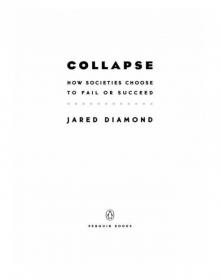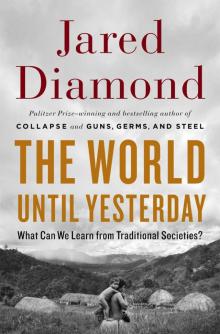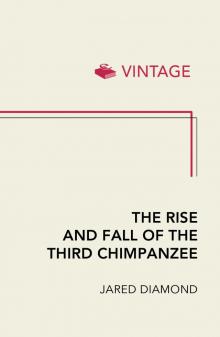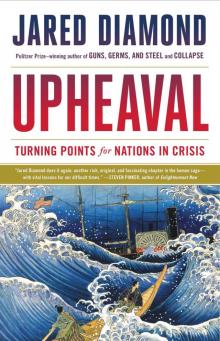- Home
- Jared Diamond
Upheaval: Turning Points for Nations in Crisis Page 9
Upheaval: Turning Points for Nations in Crisis Read online
Page 9
Here is President Kekkonen’s explanation of his own and Paasikivi’s policy, from his political autobiography: “The basic task of Finnish foreign policy is to reconcile the existence of our nation with the interests which dominate Finland’s geopolitical environment.… [Finnish foreign policy is] preventive diplomacy. The task of this diplomacy is to sense approaching danger before it is too close and take measures which help to avoid this danger—preferably in such a way that as few as possible notice that it has been done.… Particularly for a small state which harbors no illusions that the stances it takes can swing the scales one way or another, it is vitally important to be able in good time to form a correct conception of the strength of those factors on which future development in the military and political sector will depend.… A nation should rely only on itself. The war years taught us an expensive lesson in this respect.… Experience also taught us that a small country purely and simply cannot afford to mix emotions—be they feelings of sympathy or antipathy—into its foreign policy solutions. A realistic foreign policy should be based on awareness of the essential factors in international politics, namely national interests and the power of relationships between states.”
The concrete pay-offs from Finland’s adherence to the Paasikivi-Kekkonen line have consisted of what the Soviet Union (and, today, Russia) has and hasn’t done to Finland during the past 70 years. It hasn’t invaded Finland. It didn’t engineer a take-over of Finland by the Finnish Communist Party when that party existed. It did reduce the amount and extend the period of the war reparations that Finland owed and paid off to the Soviet Union. In 1955 it did evacuate its naval base and did withdraw its artillery on the Finnish coast at Porkkala, just 10 miles from Helsinki. It did tolerate Finland’s increasing its trade with the West and decreasing its trade with the Soviet Union, Finland’s association with the EEC (European Economic Community), and Finland’s joining EFTA (the European Free Trade Association). It was fully within the Soviet Union’s power to do, not to do, or to forbid most of those things. The Soviet Union would never have behaved as it did if it had not trusted and felt secure with Finland and with Finland’s leaders.
In its foreign relations Finland constantly walked a tightrope between developing its relations with the West and retaining Soviet trust. To establish that trust immediately after the Continuation War in 1944, Finland fulfilled on time all the conditions of its armistice and subsequent peace treaty with the Soviet Union. That meant driving German troops out of Finland, conducting war crimes trials against Finland’s own wartime leaders, legalizing the Finnish Communist Party and bringing it into the government while preventing it from taking over Finland, and punctually paying its war reparations to the Soviet Union, even though that involved individual Finns contributing their jewelry and gold wedding rings.
In expanding its Western involvement, Finland made efforts to reduce chronic Soviet suspicion that Finland might become economically integrated into the West. For instance, Finland found it prudent to refuse the U.S.’s offer of badly needed Marshall Plan aid. While reaching agreements with or joining the Western European associations EEC and EFTA, Finland simultaneously made agreements with Eastern European communist countries, guaranteed most-favored-nation status to the Soviet Union, and promised the Soviet Union the same trade concessions that Finland was making to its EEC partners.
At the same time as Western countries were Finland’s major trade partners, Finland became the Soviet Union’s second-leading Western trade partner (after West Germany). Container shipments through Finland were a major route for Western goods to be imported into the Soviet Union. Finland’s own exports to the Soviet Union included ships, ice-breakers, consumer goods, and materials to build entire hospitals, hotels, and industrial towns. For the Soviet Union, Finland was its major source of Western technology and its major window onto the West. The result was that the Soviets no longer had any motivation to take over Finland, because Finland was so much more valuable to the Soviet Union independent and allied with the West than it would have been if conquered or reduced to a communist satellite.
Because Soviet leaders trusted Presidents Paasikivi and Kekkonen, Finland chose not to turn over its presidents as in a normal democracy but maintained those two in office for a total of 35 years. Paasikivi served as president for 10 years until just before his death at age 86, while his successor Kekkonen served for 25 years until failing health compelled him to resign at age 81. When Kekkonen visited Brezhnev in 1973 at the time of Finland’s negotiations with the EEC, Kekkonen defused Brezhnev’s concerns by giving Brezhnev his personal word that Finland’s EEC relationship wouldn’t affect Finland’s relationship with Russia. Finland’s parliament then enabled Kekkonen to fulfill that promise, by adopting an emergency law to extend his term for another four years, thereby postponing the presidential election scheduled for 1974.
Finland’s government and press avoided criticizing the Soviet Union and practiced voluntary self-censorship not normally associated with democracies. For example, when other countries condemned the Soviet invasions of Hungary and Czechoslovakia and the Soviet war against Afghanistan, the Finnish government and press remained silent. A Finnish publishing house cancelled its plans to publish Solzhenitsyn’s novel Gulag Archipelago for fear of offending Soviet sensitivities. When a Finnish newspaper in 1971 did offend the Soviet Union by stating (truthfully) that the Baltic Republics were occupied by the Soviet Union in 1939, a Soviet newspaper denounced that statement as a bourgeois attempt to disrupt neighborly relations between Finland and the Soviet Union, and the Soviet foreign minister warned Finland that the Soviet Union expected the Finnish government to prevent such incidents in the future. The Finnish government obliged by calling on the Finnish press to exercise more “responsibility,” i.e., to self-censor such potentially offensive statements.
Finland’s tightrope act served to combine independence from the Soviet Union with economic growth. In this respect, too, Finland as a small country has had to face realities: today’s 6 million Finns will never develop the economic advantages of scale enjoyed by 90 million Germans or 330 million Americans. Finland will never succeed in economic spheres dependent on a low standard of living and the resulting ability to pay workers the low wages still widespread outside Europe and North America. By world standards, Finland will always have few workers, who will always expect high wages. Hence Finland has had to make full use of its available workforce, and to develop industries earning high profits.
In order to make productive use of its entire population, Finland’s school system aims to educate everybody well, unlike the U.S. school system, which now educates some people well but more people poorly. Finland has egalitarian, high-quality public schools with few private schools. Astonishingly to rich Americans, even those few Finnish private schools receive the same level of funding from the government as do public schools, and are not permitted to increase their funding by charging tuition, collecting fees, or raising endowments! While U.S. schoolteachers have low social status and are drawn predominantly from the lower-performing ranks of college students, Finnish schoolteachers go through a very competitive selection process, are drawn from the brightest high school and university students, enjoy high status (even more than university teachers!), are well paid, all have advanced degrees, and have lots of autonomy in how they teach. As a result, Finnish students score at or near the top of world national rankings in literacy, math, and problem-solving abilities. Finland gets the best out of its women as well as out of its men: it was the second country in the world (after New Zealand) to extend the vote to women, and its president happened to be a woman at the time of one of my visits. Finland even gets the best out of its police: again astonishingly to Americans, Finnish police have to have a university bachelor’s degree, are trusted by 96% of Finns, and almost never use their guns. Last year, Finnish police on duty fired only six shots, five of them just warning shots: that’s fewer than an average week of police gunshots in my city of Los Angel
es.
That strong focus on education yields a productive workforce. Finland has the world’s highest percentage of engineers in its population. It is a world leader in technology. Its exports account for nearly half of its GDP (gross domestic product), and its main exports are now high-tech—heavy machinery and manufactured goods—instead of timber and other conventional forest products as was the case before World War Two. Finland has become a world leader in the development of new high-tech products from its forests, such as electricity generation, fertilizers, textile fibers to replace wool and copper, and even guitars. Finland’s combined private and government investment in research and development equals 3.5% of its GDP, almost double the level of other European Union countries, and (along with the percentage of its GDP spent on education) close to the highest in the world. The result of that excellent educational system and those high investments in research and development is that, within just half-a-century, Finland went from being a poor country to being one of the richest in the world. Its average per-capita income is now equal to that of France, Germany, and the United Kingdom, all of which have populations 10 times that of Finland and have been rich for a long time.
When I visited Finland in 1959, knowing almost nothing about the history of Finland’s two wars with the Soviet Union, I asked my Finnish hosts why Finland deferred to the Soviet Union in so many ways, imported those inferior Moskvich cars, and was so afraid about the possibility of a Soviet attack on Finland. I told my Finnish hosts that the United States would surely defend Finland if the Soviet Union attacked. In retrospect, there was nothing more cruel, ignorant, and tactless that I could have said to a Finn. Finland had bitter memories that, when it actually was attacked by the Soviet Union in 1939, it had not been helped by the U.S., Sweden, Germany, Britain, or France. Finland had to learn from its history that its survival and independence depended on itself, and that Finland would be safe only if the Soviet Union felt safe and trusting towards Finland.
My ignorant attitude has been shared by many non-Finns who should have known better, but who instead labeled Finnish policy by the derogatory term “Finlandization.” As a definition of Finlandization, here is one from the New York Times in 1979: “A deplorable state of affairs in which a small and weak neighbor, awed by the might and political ruthlessness of a totalitarian superpower, makes shameless and embarrassing concessions of its sovereign liberties.” Those who decry Finlandization consider Finland’s policy to be cowardly.
Many Finnish actions do indeed horrify Western European and American observers. It could never happen in the U.S. or Germany that a presidential election would be postponed, a presidential candidate would withdraw his or her candidacy, a publisher would cancel a book, or the press would censor itself, just to avoid inflaming Soviet sensitivities. Such actions seem to violate a democracy’s right to freedom of action.
But the sensitivities of other countries are a problem for every country. To quote President Kekkonen again, “A country’s independence is not usually absolute… there was not a single state in existence that did not have to bow to historical inevitabilities.” There are obvious reasons why Finland has to bow much more to historical inevitabilities than does the U.S. or Germany: Finland is small and borders on Russia, while the U.S. and Germany do not. What do the critics who decry Finlandization think that Finland should instead have been doing?—risk still another Soviet invasion, by not considering Soviet reactions?
Part of the fear behind non-Finnish critics’ objections to Finlandization stemmed from their concern that the communist Soviet Union might lull their own countries into deference to the Soviet Union. But other Western European countries and the U.S. exist in an entirely different geopolitical situation and don’t have to deal with Finland’s geopolitical problems. Kekkonen’s defense of Finland’s policy was summarized in the phrase “Finlandization is not for export.”
In fact, Finland’s foreign policy towards the Soviet Union has of necessity been Byzantinely complex. The end result is that, in the 70 years since the end of World War Two, Finland has come no closer to becoming a Soviet or (now) a Russian satellite. Instead, it has succeeded in steadily increasing its ties with the West while still maintaining good ties with Russia. At the same time, Finns know that life is uncertain, and so military service is still compulsory for Finnish men and voluntary for Finnish women. Training lasts up to a year and is rigorous, because Finland expects that its soldiers must really be able to fight. After that year of training, Finns are called up for reserve duty every few years until age 30–35 or older. The reserve army constitutes 15% of Finland’s population—as if the U.S. maintained a reserve army of 50 million.
Let’s now evaluate, in the light of Finland’s recent history, the dozen factors postulated as associated with resolution of national crises (Table 1.2), by analogy to the factors relevant to personal crises (Table 1.1). Among those factors, seven of them favored, one of them initially hindered and subsequently favored, and the lack of three of them hindered Finland’s resolution of its fundamental problem: the threat from its powerful neighbor.
The seven factors associated with crisis solution that Finland conspicuously displayed were acceptance of responsibility (factor #2), building a fence (#3), strong national identity (#6), honest self-appraisal (#7), dealing with national failure (#9), flexibility (#10), and national core values (#11). First, among the nations discussed in this book, Finland is the outstanding example of acceptance of responsibility and honest ultra-realistic self-appraisal. Its re-appraisal was especially painful because Soviet armies had killed, widowed, orphaned, or made homeless a large fraction of Finland’s population. Finns had to avoid falling into the trap of letting self-pity and resentment paralyze their relations with the Soviet Union. But they finally recognized realities: that Finland is small; that it shares a long border with the Soviet Union; that it could not count on its allies for effective support; that the responsibility for its survival lay entirely with itself; and that it was strong enough to resist the Soviet Union for a while, and to make a Soviet invasion slow and costly and painful for the Soviets, but that it could not resist the Soviets forever. Finns learned from the mistakes of their pre-war foreign policy. They finally faced the fact that the only way that they could retain their political independence was by earning Soviet trust, and by sacrificing some economic independence and freedom to speak out.
Finland illustrates well our theme of selective change and building a fence (factor #3). In its eventual response (after September 1944) to the Soviet attack, Finland reversed its long-standing previous policy of trying to ignore and not deal with the Soviet Union. It adopted a new policy of economic involvement and frequent political discussions with the Soviet Union. But those changes were highly selective, because Finland remained unoccupied, politically self-governing, and a socially liberal democracy. That coexistence of two seemingly contrasting identities, one changed and the other unchanged, has puzzled and angered many non-Finns, who coined the scornful term “Finlandization” and implied that Finland could and should have done something different.
Finland exhibits outstandingly strong national identity (factor #6)—much more than someone unfamiliar with Finland would have expected of such a small country that otherwise seems typically Scandinavian. Finland’s national identity and belief in Finland’s uniqueness have arisen especially from its beautiful but unique and difficult language, which few outsiders even attempt to learn; from the oral epic poetry associated with that language (the Kalevala); and from Finland’s century-long history of autonomy under Russian tsarist rule, when Finland already had its own administration, currency, and parliament. Further contributing to Finland’s national identity has been the worldwide recognition of its musicians, athletes, architects, and designers. Today, Finland’s national identity also rests heavily on pride in its military achievements during the Winter War. Finns view World War Two with pride, more than do the citizens of any other country except Britain. Finland’s 2017 cen
tenary celebrations of its independence focused on its World War Two achievements at least as much as on its 1917 achievement of independence: that’s as if American celebrations of our Independence Day (July 4) were to focus on our victory in World War Two rather than on our Declaration of Independence in 1776.
Finland illustrates willingness to tolerate initial failure, and to persist in experimenting with solutions to a crisis until it finds a solution that worked (factor #9). When the Soviet Union issued its demands to Finland in October 1939, Finland did not respond by offering the economic and political involvement that it eventually adopted. Even if Finland had made such an offer then, Stalin would probably have refused the offer; it required Finland’s ferocious resistance in the Winter War to convince Stalin to leave Finland independent. Instead, from 1944 onwards, when Finland recognized the failure of its pre-war policy of ignoring the Soviet Union and of its wartime policy of seeking a military solution, Finland went through a long and almost uninterrupted period of experimentation in order to discover how much economic and political independence it could retain, and what it had to do to satisfy the Soviet Union in return.
Finland illustrates flexibility born of necessity (factor #10). In response to Soviet fears and sensitivities, Finland did things unthinkable in any other democracy: it put on trial and imprisoned its own wartime leaders according to a retroactive law; its parliament adopted an emergency decree to postpone a scheduled presidential election; a leading presidential candidate was induced to withdraw his candidacy; and its press self-censored statements likely to offend the Soviet Union. Other democracies would consider those actions as disgraceful. In Finland those actions instead reflected flexibility: sacrificing sacred democratic principles to the extent required to retain political independence, the principle held most sacred. Quoting again from Zaloga’s biography of Mannerheim, Finns have excelled at negotiating “the least awful of several very bad options.”

 Why Is Sex Fun?: The Evolution of Human Sexuality
Why Is Sex Fun?: The Evolution of Human Sexuality Guns, Germs, and Steel: The Fates of Human Societies
Guns, Germs, and Steel: The Fates of Human Societies Collapse: How Societies Choose to Fail or Succeed
Collapse: How Societies Choose to Fail or Succeed The Third Chimpanzee: The Evolution and Future of the Human Animal
The Third Chimpanzee: The Evolution and Future of the Human Animal The World Until Yesterday: What Can We Learn From Traditional Societies?
The World Until Yesterday: What Can We Learn From Traditional Societies? The Rise and Fall of the Third Chimpanzee
The Rise and Fall of the Third Chimpanzee Upheaval: Turning Points for Nations in Crisis
Upheaval: Turning Points for Nations in Crisis Guns, Germs, and Steel
Guns, Germs, and Steel The Third Chimpanzee for Young People
The Third Chimpanzee for Young People Why Is Sex Fun?
Why Is Sex Fun?